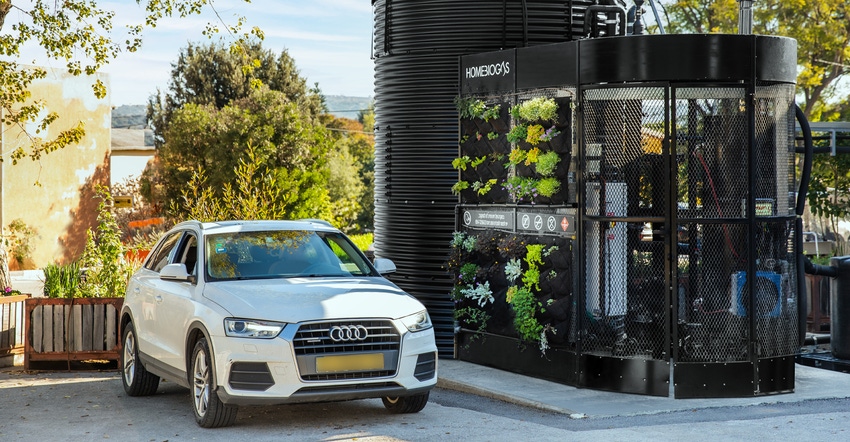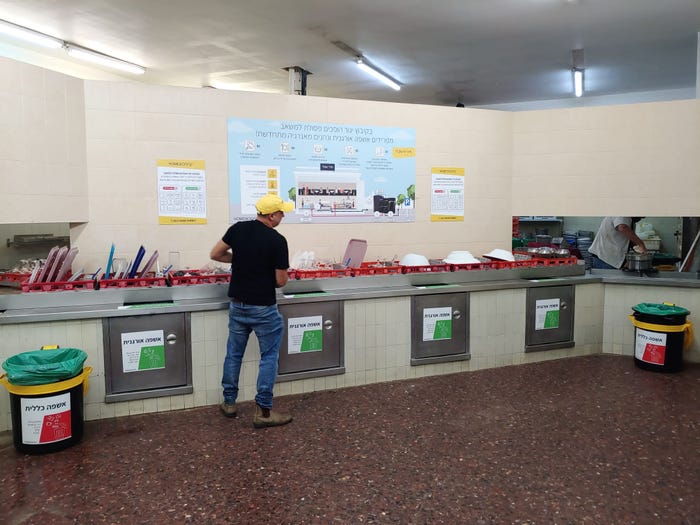Israeli Kibbutz Converts Kitchen Food Waste to Energy On-Site
Kibbutz Yagur, a small Israeli community of 350 families who live together, is operating an anaerobic digester (AD) that breaks down food waste and converts it to biogas, meaning no longer having to make the 62-mile roundtrip haul to the nearest disposal site. The community's biggest issue? Trying to communicate waste as an asset.

Kibbutz Yagur is a small Israeli community of 350 families who live together; most who eat together in food prepared in one kitchen and served from one communal dining hall. That’s nearly 1,000 meals a day, and until recently all the resulting food waste – both from the kitchen and what was left in plates –went to a landfill, adding to the mountains of garbage accumulating there. About 80% of Israel’s waste is landfilled, and the small state is close to running out of disposal space, warns Israel’s Environmental Protection Ministry.
Kibbutz Yagur has shifted gears, now operating an anaerobic digester (AD) that breaks down food waste and converts it to biogas, meaning no longer having to make the 62-mile roundtrip haul to the nearest disposal site. Rather the community now manages all its organic kitchen waste on site, while generating renewable energy to heat water used in the utility dishwasher. Residue at the end of the AD process is mixed with a little water and serves as fertilizer for a garden.
The system, spread over the equivalent of two parking spaces, is one of two commercial beta sites designed and built by HomeBiogas, who has sold about 15,000 smaller units for residential homes across the globe. As HomeBiogas learns from the beta commercial-scale project at Yagur and from another beta in progress, it’s landed two commercial-system sales.
The two new commercial systems should launch late in 2022; one for the Israeli army and another to be announced soon in the hospitality arena. Plans are to roll out the larger model in the U.S. this year too, according to Oshik Efrati, CEO HomeBiogas.

Says Eran Lerner, chief environmental officer at Kibbutz Yagur: “Now we will avoid air pollution, greenhouse gases, and traffic jams [by no longer having to haul food waste]. But that’s not the main issue.
The main issue is we are trying to educate our community to recycle and to understand ‘waste’ is an asset. To explain you can use it for energy and to save money.”
Kibbutz Yagur now saves about $200 per ton by avoiding a $40 per ton tipping fee, gas, and wear and tear on the trucks, translating to $1,500 a month, on top of money saved to heat water. At the same it diverts the ton of kitchen food waste it generates every four days.
The actual process is not complicated. The community simply separates food waste after meals and sees that it goes into a newly introduced receptacle. Green signs tell people what’s organic to be diverted, and red signs note what’s trash that will go to landfill.
Still, changing old habits took some explaining and a few weeks, with guides standing near the bins to reinforce the new protocol, as well as a little education beyond that.
“What you should do seems obvious, but it takes learning,” Lerner says. The largest educational piece focused on teaching the kids.
They attended classes in the dining room. When they finished their meals, they helped separate organic waste from other material and were shown pictures of the system illustrating the process. They toured to see the instruments and facility as well as the garden.
“So, we explain not just how to separate, but what we can make – the energy. And we show them the plants growing [nourished by the residue from the AD process that’s applied as liquid fertilizer],” Lerner says.
Getting adults accustomed to the change was a little harder. But Lerner says the children taught and reminded their parents, grandparents, sisters, and brothers.
“The main point was to get kids and adults to separate; to make them proud of the project; and point out this system is unique to Israel. It’s the second in the world made by HomeBiogas at this large scale,” Lerner says.
For kitchen workers making the transition was also just a matter of changing habits. The process is quick and simple, says Nevo Goldstein, Food Services manager, Kibbutz Yagur. Workers feed leftovers into a compact food grinder that turns solid organics into liquid, which makes its way by pipe to the HomeBiogas system. It can receive 70.5 pounds of garbage every two minutes. And there’s been a 50% reduction in the amount of fat that flows to the sewerage system, Goldstein says.
The digesters, made of durable 100% recyclable material, have automated monitoring and can run remotely. They require low maintenance and are airtight, so they are odorless, Efrati says.
The smallest of the household models (for residential use) has a daily capacity to process up to 1.5 gallons of organic waste and generate up to two hours of cooking gas. Customers using household systems are a mix.
“Some are suburbanites, off-gridders, tiny housers, etc., that want to use renewable energy while recycling their organic waste. Others, as examples, are refugees in United Nations camps in Africa or corporate social responsibility projects in India where our systems help with sanitation, clean cooking, and sustainable farming, Efrati says.
HomeBiogas is targeting hospitals, schools, hotels, and other institutional and business operations for the commercial system, which enables the transformation of up to 1 ton of waste per day into 1MMbtu of clean energy in the form of biogas used for heating water.
The company believes this is the right time to expand to industrial kitchens.
“They are ready for and in need of innovation in order to comply with recent regulations and laws associated with organic waste management. They need to lower their costs associated with disposing of waste. And they need to limit the damaging greenhouse gas effect of landfills,” Efrati says.
Lerner sees that key to having real impact on greenhouse gas emissions is managing garbage locally.
“If you routinely travel 50 to 200 kilometers to a landfill it’s a disaster. Plus, we don’t have much land for waste. We need to use it more wisely.
Every community should get rid of [organic waste] where they live. That way everyone takes responsibility for what they generate.”
About the Author(s)
You May Also Like




